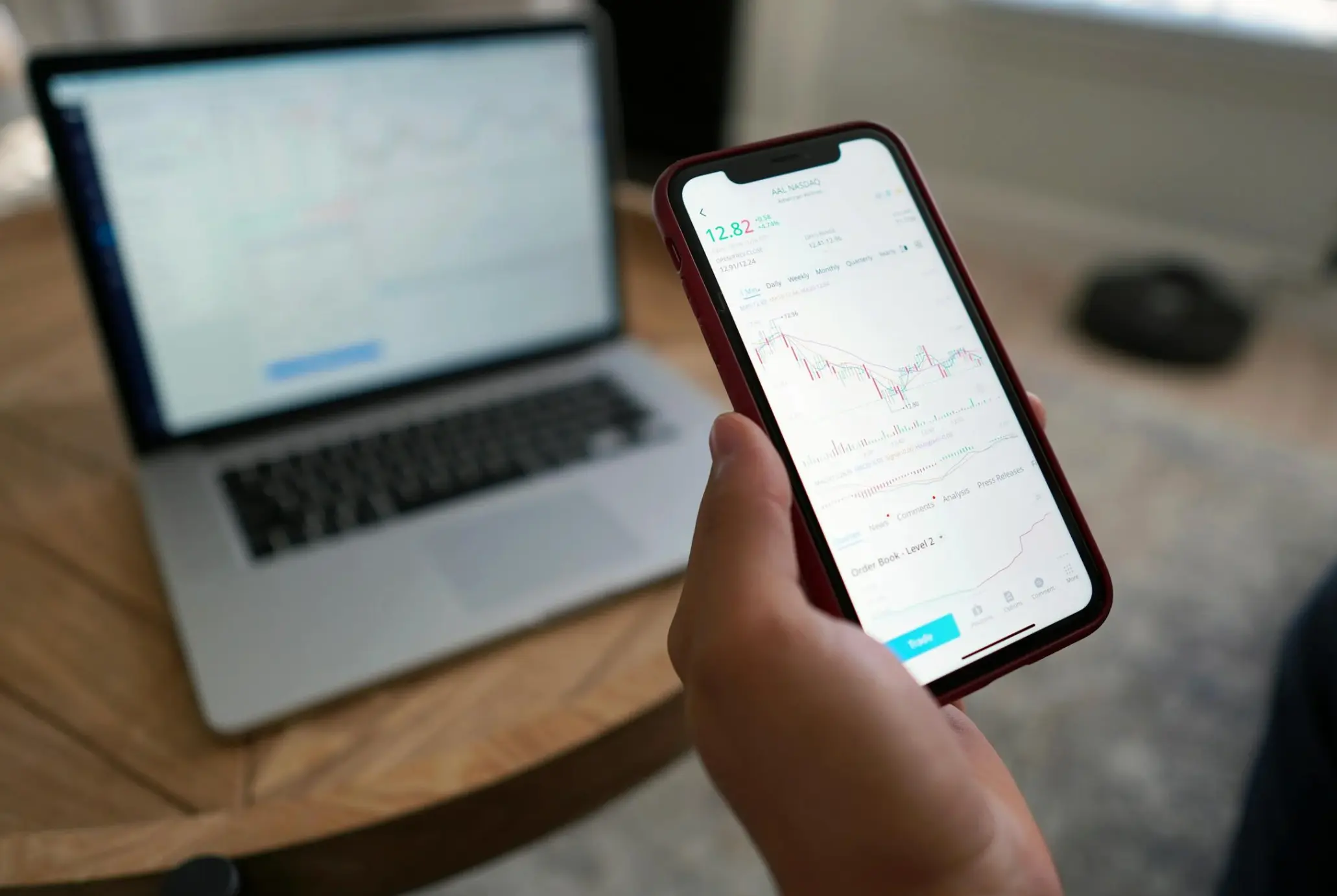Invest In Website Speed: Proving Website Speed ROI Through Core Web Vitals
Updated on
Published on
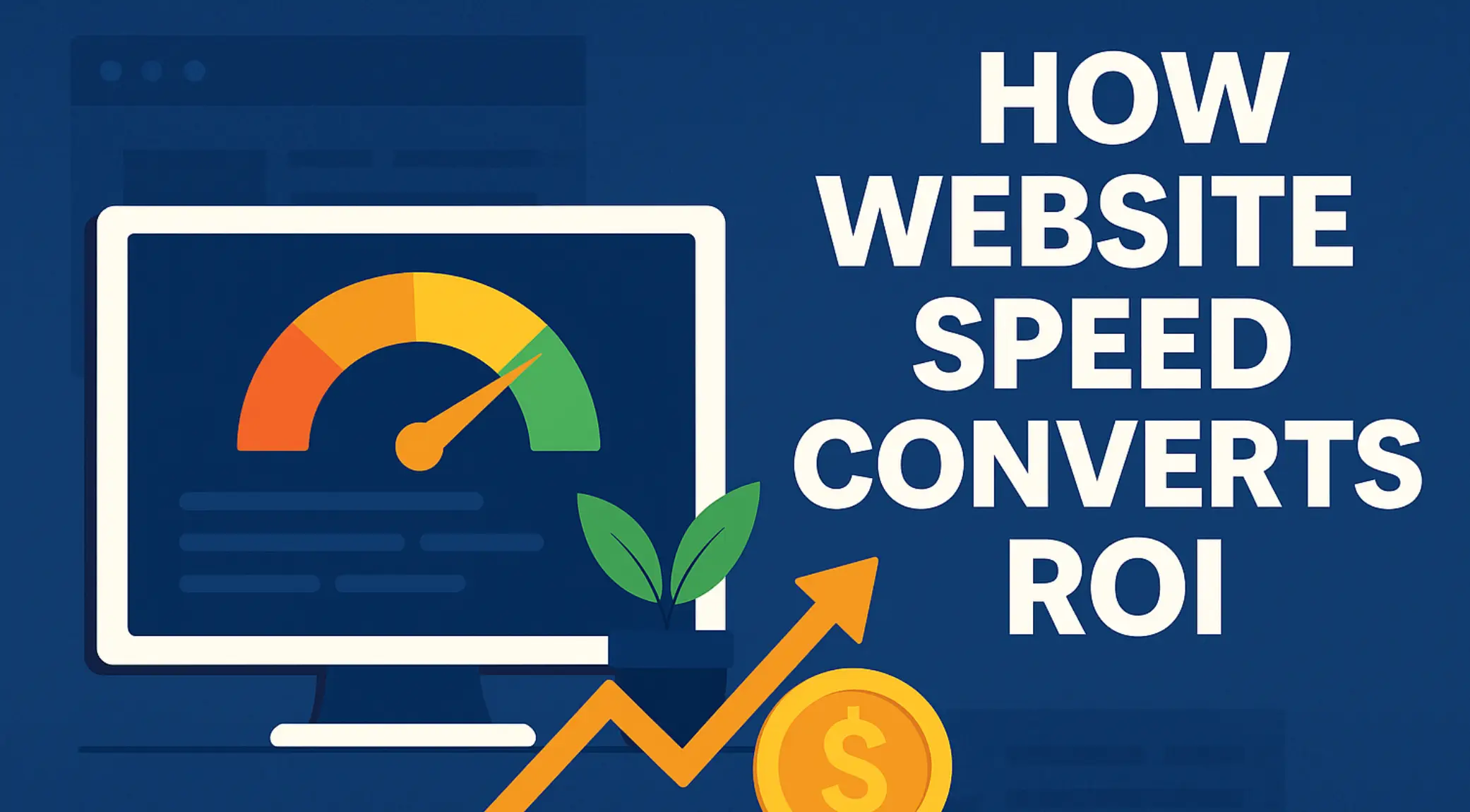
Great design attracts attention, but performance closes the sale. Pages that load quickly and stay steady earn trust and higher conversions. That is why website speed ROI is not a theory, it is a chain of tiny wins that add up to money. If you have ever asked how does website speed convert ROI, the answer lives inside core web vitals, where better LCP, INP, and CLS turn curiosity into clicks, carts, and customers. For definitions and targets, keep the core web vitals documentation close by (Google Search Central).
At a glance
- Passing core web vitals correlates with better user outcomes and can contribute to ranking success when content relevance is similar across results (Google Search Central).
- A 0.1 second mobile speed improvement lifted progression and conversion across the purchase funnel in a multi brand study, a clear core web vitals ROI signal (Deloitte).
- Conversion rates drop as load time climbs past roughly four seconds across thousands of landing pages (Portent).
- INP replaced FID in March 2024, so interactivity is now the responsiveness KPI to optimize for ROI (web.dev).
The speed to the revenue chain
Speed lowers bounce, raises consideration, and increases completed actions. In retail and travel, even a 0.1 second mobile improvement increased funnel progression, page views, and conversion, which explains why website speed ROI compounds over time as more sessions make it deeper into the journey (Deloitte).
- Fewer abandons at the first screen means more product views.
- Faster taps make checkout feel safer and more predictable.
- The same speed wins also improve ad Quality and post click engagement.
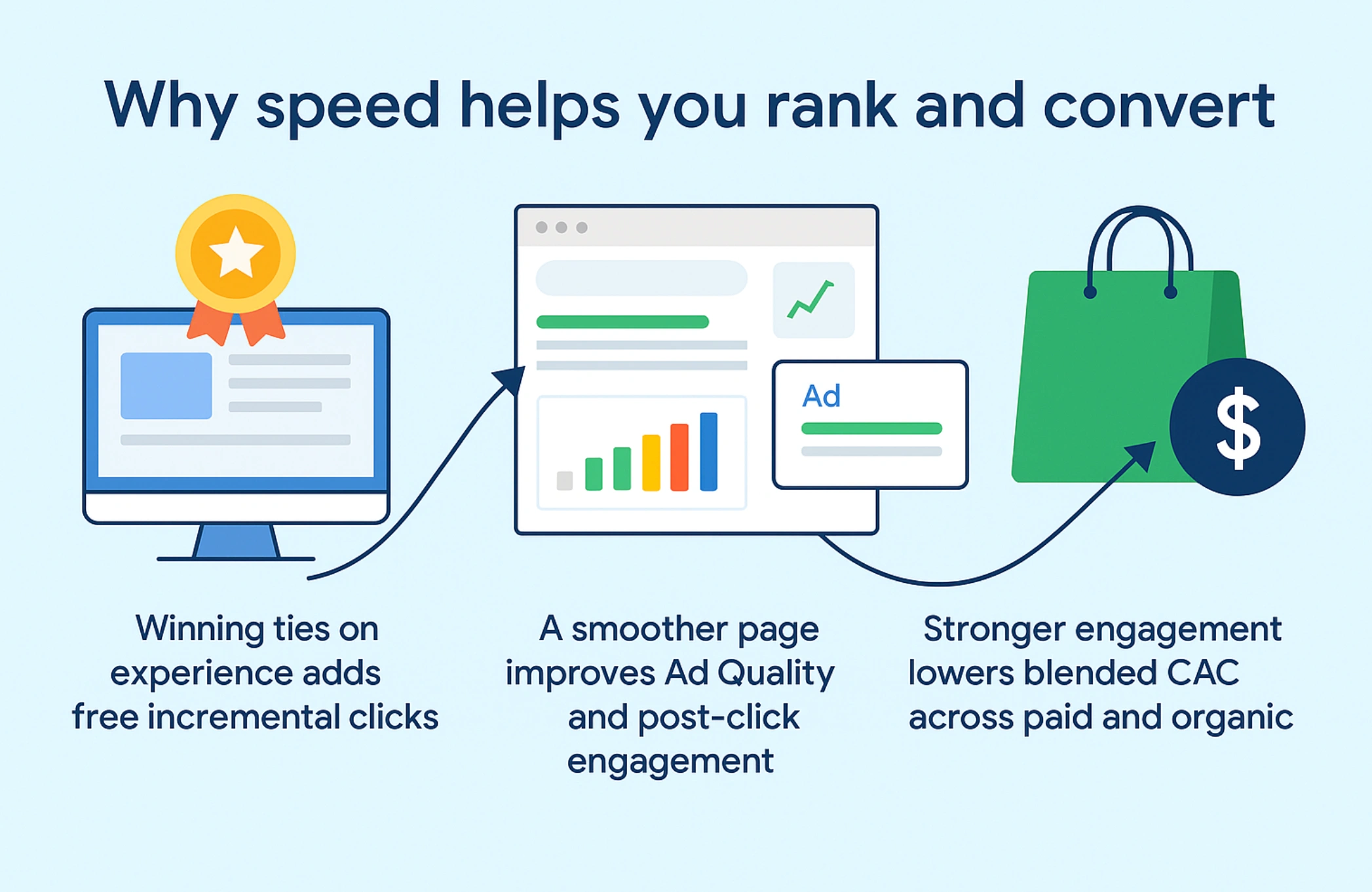
Core Web Vitals Explained
Core web vitals measure three things users feel. LCP is how fast the main content element loads (Largest Contentful Paint). INP is how quickly the page responds when you tap (Interaction to Next Paint). CLS is how stable the layout is while things load (Cumulative Layout Shift). Good targets are LCP ≤ 2.5 s, INP < 200 ms, CLS < 0.1, because that is where frustration turns into flow (Google Search Central).
- LCP is usually your hero image or headline block.
- INP looks at all interactions, not just the first touch.
- CLS punishes jumpy UIs that push buttons as ads or images load.
-1.webp)
INP is the new responsiveness KPI
Since March 2024, INP (Interaction to Next Paint) is the responsiveness vital that matters. It watches every interaction, from input to event handler to paint, and surfaces your worst offender. If you only tuned FID in the past, you are leaving core web vitals ROI on the table, because users judge lag on every tap (web.dev).
- Break up long tasks so the main thread can paint between chunks.
- Defer non critical JavaScript and hydrate less on first load.
- Prioritize input handlers for menus, carousels, and modals (web.dev).
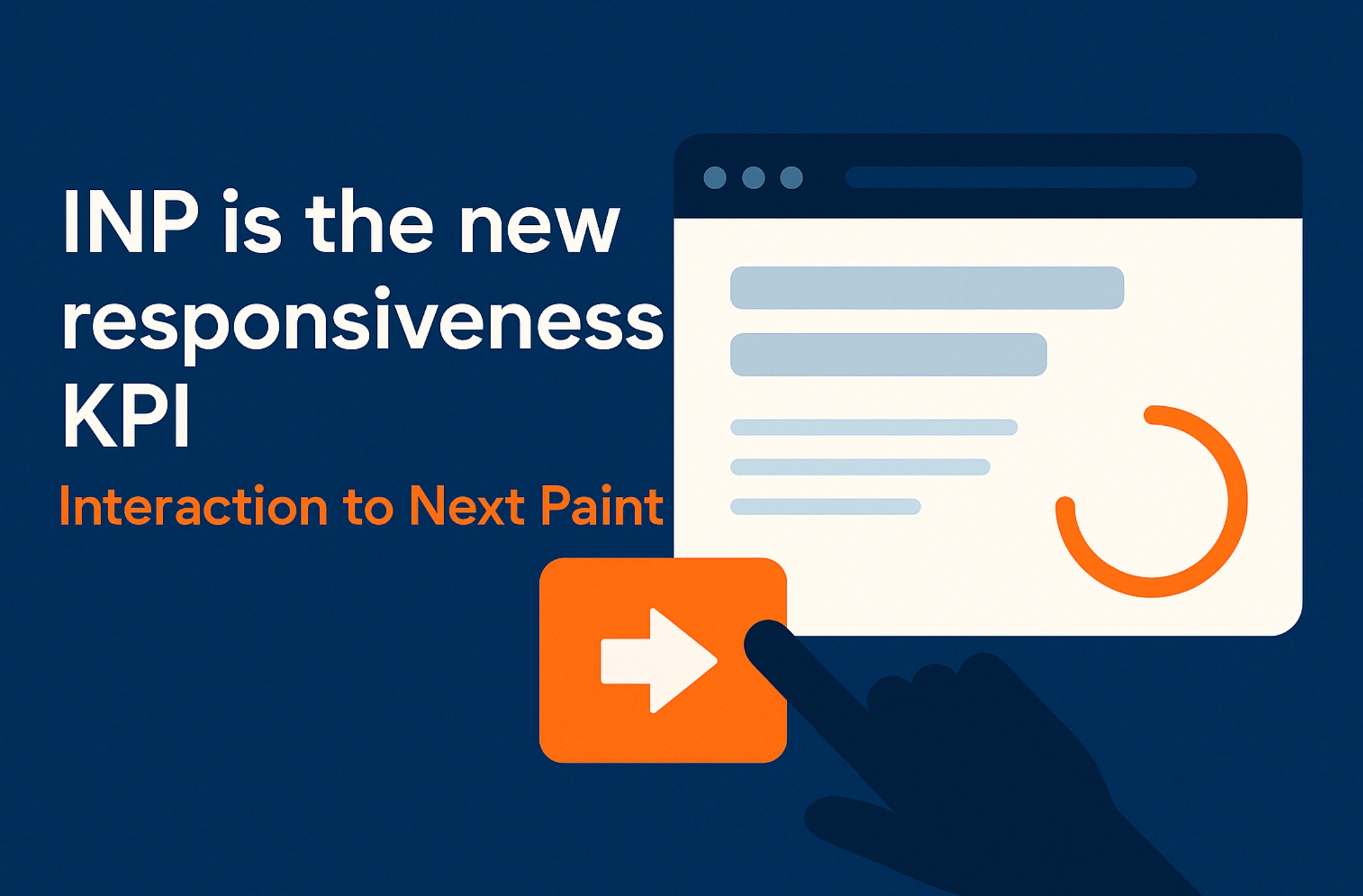
Why speed helps you rank and convert
Google will surface the most relevant content even if a page is not perfect, yet when many pages are helpful, better page experience can contribute to ranking success. That means faster, more stable pages compound ROI twice, first by converting more visitors and second by capturing more qualified traffic in competitive results (Google Search Central).
- Winning ties on experience adds free incremental clicks.
- A smoother page improves ad Quality and post click engagement.
- Stronger engagement lowers blended CAC across paid and organic.
The math: how does website speed convert ROI
Tie a single Vital to money. Example: your product page LCP improves from 3.2 s to 2.4 s. Conversion on “Good” sessions rises from 2.1 percent to 2.4 percent. If those sessions drive 200,000 monthly visits with a 120 dollar AOV and 50 percent gross margin, the lift is 0.3 points on conversion or 600 extra orders worth 72,000 dollars gross profit per month. Annualize, subtract your core web vitals optimization cost, and you have website speed ROI you can defend.
- ROI ≈ (Incremental orders × AOV × gross margin) − core web vitals optimization cost.
- Use matched cohorts to control for seasonality and channel shifts.
- Report per template first, then roll up sitewide.
.webp)
Budgeting the fix: core web vitals optimization cost
You do not need a blank cheque to show core web vitals ROI. Most teams can scope core web vitals optimization cost into a handful of workstreams that map cleanly to metrics: render path cleanup for LCP, media pipeline upgrades for LCP and CLS, JavaScript diet for INP, and edge delivery for TTFB. Add a light QA and monitoring track so wins do not regress after new releases. Prioritise the two or three templates that generate the most revenue or leads and schedule one sprint per template so progress feels tangible and easy to measure.
- Render path cleanup: remove render blocking scripts, inline critical CSS, and set fetchpriority="high" on the hero.
- Media pipeline: modern formats, compression, explicit width and height for images and embeds, and a CDN (content delivery network) for heavy assets.
- JavaScript diet: break up long tasks, defer non essentials, hydrate less on first paint.
- Back end and network: cache HTML, enable HTTP 3, and push TTFB toward 0.8 seconds at the 75th percentile.
- QA and monitoring: set field data alerts for LCP, INP, CLS so regressions are caught fast.

The highest ROI fixes for Core Web Vitals
Focus on what users see first and touch most. LCP is usually your hero block, so never lazy load it, compress the asset hard, and promote it with priority hints so the browser asks for it immediately. INP improves when you reduce main thread work and keep handlers light, especially on nav, filters, and modals. CLS drops when you reserve space for images, ads, and embeds so nothing jumps while loading. These changes are visible to users, easy to explain to stakeholders, and fast to validate in field data (web.dev).
- LCP: preconnect needed domains, compress hero assets, and promote the image with fetchpriority="high" (web.dev).
- INP: break up long tasks and avoid synchronous third party scripts that block the UI loop (web.dev).
- CLS: add width, height, or aspect-ratio on images and embeds so space is reserved (web.dev).
Server speed still matters
Front end optimisations cannot fully mask a slow origin. If time to first byte is high, your first paint and your LCP suffer even with perfect images and CSS. Aim for a TTFB near 0.8 seconds at the 75th percentile, cache aggressively, and move assets to a CDN close to users. Modern protocols like HTTP 3 and smart connection hints can shave costly milliseconds on mobile networks where latency is the real enemy (web.dev).
- Cache HTML for popular pages and render personalised bits on the edge.
- Preconnect to critical domains and keep TLS modern to reduce handshake time.
- Use priority hints to fetch the hero image and key fonts sooner (web.dev).
Real world proof points you can quote
Speed is not only a lab goal, it is a revenue habit. Independent analyses across thousands of sites show that keeping loads under roughly four seconds preserves conversion rates, while educational resources explain why slow seconds leak audiences you worked hard to acquire. Pick one benchmark for each key template and communicate it like a product success metric so teams internalise the stakes (Portent) (web.dev).
- Choose a north star per template, for example LCP 2.0 seconds or INP 120 milliseconds.
- Tie those targets to dollars in weekly reports so progress reads like ROI.
- Celebrate wins with before and after field data so momentum stays high.
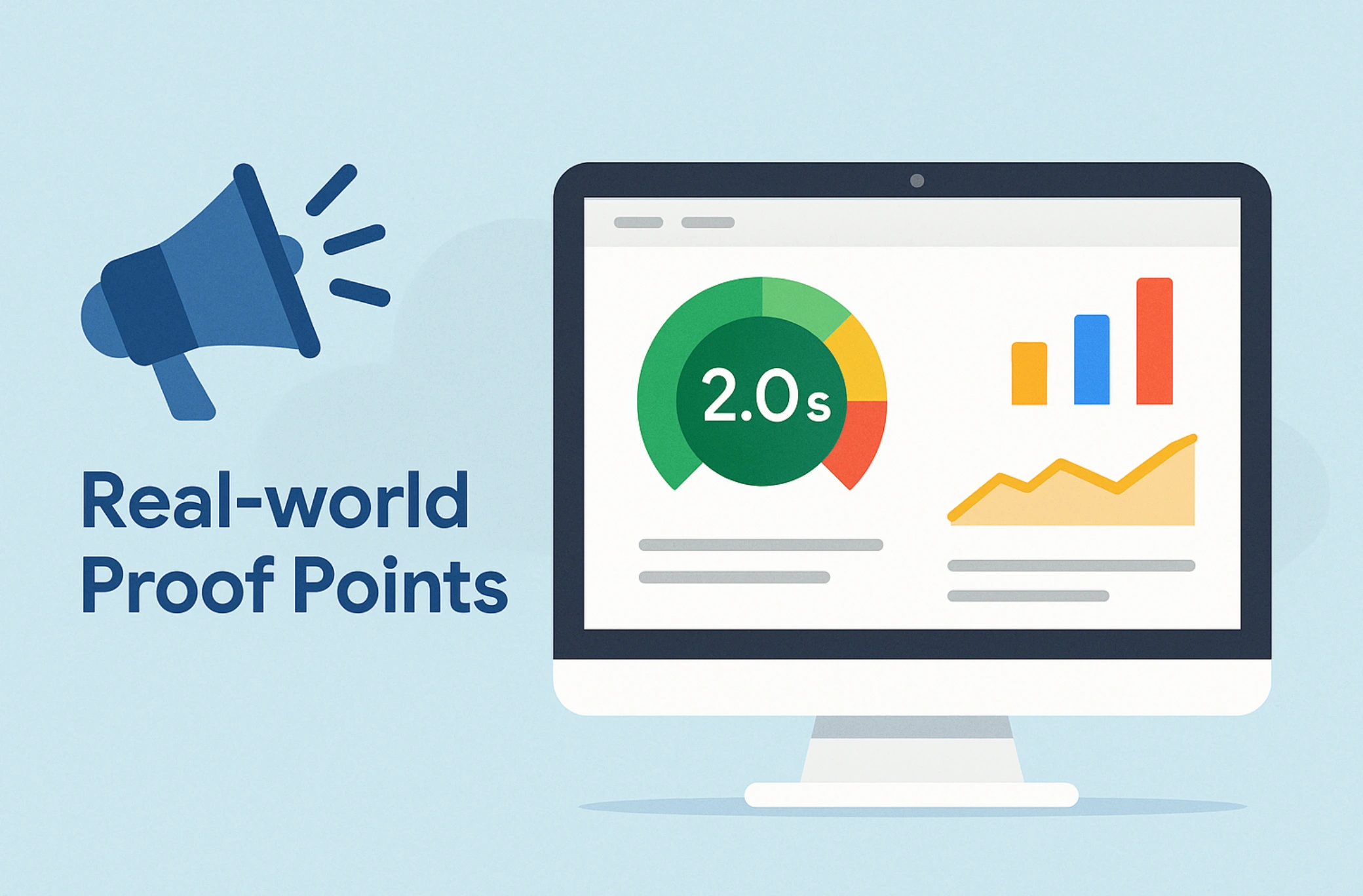
Measurement that Finance will trust
Rely on field data and language your Finance department recognises. Group sessions by web vitals status, compare conversion and revenue per session, and only report deltas once they are statistically stable over a 28 day window. Search Console shows where real users struggle at scale, and those cohorts align cleanly with analytics segments for ROI tracking. This is how you replace subjective claims with a repeatable website speed ROI model that can be refreshed every month (Search Console Help).
- Avoid mixing in promo periods unless both variants ran in parallel.
- Track lifts per template, then roll up to a sitewide number for leadership.
- Keep a living doc that logs change dates and the field metrics that followed.
Invest In Website Speed With Professionals
Partner with Brand Vision to turn performance into profit. We start with a focused audit that maps your user journey to core web vitals, then prioritize fixes that move the needle on LCP, INP, and CLS so you can prove website speed ROI in weeks, not quarters. Our team ships quick wins like media compression, priority hints, and caching, then tackles deeper Core Web Vitals optimization with lightweight JavaScript, edge delivery, and clean templates.
- We provide clear reporting that translates technical speed improvements directly into conversion rate uplifts and measurable revenue gains for Finance.
- Our approach guarantees future performance by training your internal teams and establishing a sustainable performance budget for all new features.
.webp)
A 90 day speed to ROI plan
Make speed a product, not a side quest. Three focused sprints are enough to generate measurable core web vitals ROI and a clear story for stakeholders.
- Days 1 to 30 baseline and quick wins: identify the LCP element, promote it with fetchpriority="high", compress media, remove render blocking scripts, and add explicit dimensions to images and embeds to kill CLS. These moves are visible to users and easy to validate in the field (web.dev).
- Days 31 to 60 interactivity: profile long tasks, split heavy work, ship skeleton UIs, prioritise input handlers, and verify improvements in INP from real users. Target the interactions people use the most so gains are obvious (web.dev).
- Days 61 to 90 back end and network: cache HTML, push static assets to a CDN, enable HTTP 3, and tune origin so TTFB approaches 0.8 seconds at the 75th percentile. Close the loop by reporting revenue lifts by template against your core web vitals optimization cost (web.dev).
FAQ
What is the fastest way to prove website speed ROI?
Fix the hero LCP and one long task that hurts INP on your top revenue template, then compare Good versus Needs improvement sessions for conversion and revenue per session over the next 28 days.
Does speed help rankings or just conversions?
Both can benefit, since better page experience can contribute to success in competitive results while also lifting conversion once visitors arrive.
Which Vital usually delivers the biggest lift?
LCP fixes are fastest to feel and often drive the earliest core web vitals ROI on product and lead pages because they improve what users see first.
What changed with INP replacing FID?
INP measures all interactions, so you must break up long tasks, keep handlers light, and preserve a responsive UI loop throughout the session.
What is a realistic core web vitals optimization cost?
Budget for an audit, a media pipeline tune up, JavaScript long task work, and caching or CDN upgrades, then concentrate sprints on the pages that drive most revenue so cost-to-impact stays favourable.
The Lasting Effect of Fast Sites
Speed is the most honest conversion tactic. You remove friction, people finish tasks, revenue rises, and your rankings often get a friendly tailwind. Treat LCP, INP, and CLS as the scoreboard for core web vitals ROI, estimate core web vitals optimization cost with the same discipline you use for paid media, and the answer to how does website speed convert ROI will keep proving itself every time a faster page earns one more order.



